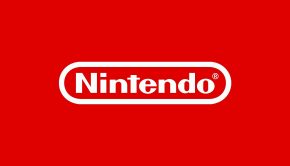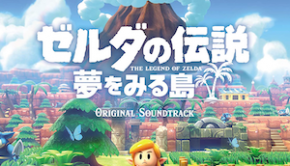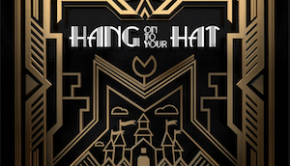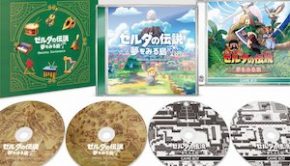The Legend of Zelda -Majora’s Mask 3D- Original Soundtrack
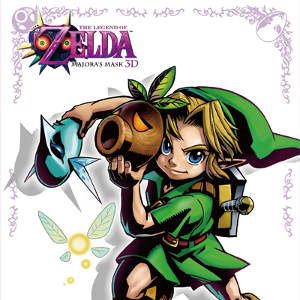 |
Album Title: The Legend of Zelda -Majora’s Mask 3D- Original Soundtrack |
| Record Label: Tablier Communications |
|
| Catalog No.: TSCM-0029/30 |
|
| Release Date: October 7, 2015 |
|
| Purchase: Buy at CDJapan |
Overview
Majora’s Mask was a very memorable experience for Nintendo 64 players. While it shared many of the same mechanics and characters as Ocarina of Time, its twisted story, rich world, and time system made it a daring addition to the series nonetheless. Koji Kondo’s score for the title was similarly a mixture of old and new. Much of the soundtrack was very familiar, whether the synth samples used, direct reprises from Ocarina of Time, or the similarly styled dungeon, action, and light-hearted music. However, it also presented a vivid interpretation of an unfamiliar but doomed world with its main theme and central tracks. Majora’s Mask 3D provided players a chance to revisit Nintendo’s world complete with updated visuals and sound. Tablier Communications, recently responsible for several soundtrack releases for the Fire Emblem series, released a two-disc soundtrack featuring all the music from the game. While it largely retreads the same ground as the soundtrack release for the original version, The Legend of Zelda -Majora’s Mask 3D- Original Soundtrack offers several improvements too: longer track times, slightly enhanced sound, new packaging, and an exclusive bonus track.
Body
Featuring near-identical musical content to the original game, the soundtrack to Majora’s Mask 3D provides a very good representation of the game’s peculiar storyline. In the game, the lonely bully Skull Kid uses the cursed artefact Majora’s Mask to summon the destruction of the mysterious world Termina; through repeatedly living three days through time travel, Link must prevent Termina’s moon from abandoning orbit and crashing into the world. The representation of the antagonist, the mask Majora, takes the form of a series of dramatic pieces influenced by Chinese opera. For example, the music for the title screen gradually darkens from a soft interpretation of the Clock Town music into the horrifying exposition of “Majora’s Theme”, as the threat above a bustling community is revealed.
The game revolves around Clock Town in the centre of Termina, a community where plenty of curious events happen over a three day period. The background music used there grows progressively more disturbing over the three days. After opening with the same morning music from the Ocarina of Time, “Clock Town – Day 1” develops into a lyrical piece of folk dance music with a very charming melody presented by a group of synthesized string and flute players. “Clock Town – Day 2”, on the other hand, is slightly eerie due to the removal of percussion and use of solo instruments, as opposed to ensembles, to represent the main melody; the minimalist approach makes it sound slightly ‘wrong’, even if the chord progressions and melody are well-preserved. “Clock Town – Day 3” is the darkest and most dissonant of all. It has a hurried tempo that reflects desperation and is accompanied by a descending chromatic string ostinato that gives a sense of impending doom. The final six hours of Clock Town’s existence are represented by “Last End,” one of the most emotional themes to ever appear on the Zelda franchise. Its deep chord progressions, synth swells, and carefully constructed ostinati assimilate into a piece that is simultaneously enchanting, saddening, and epic.
Like Hyrule, Termina is a colourful world and Kondo offers a diverse set of themes to represent this. Those who prefer Zelda’s more melodic pieces will be delighted to hear that, by popular demand, the overworld theme from The Legend of Zelda and A Link to the Past has returned. The unforgettable melody of “Termina Field” glides over the adventurous percussion-dominated accompaniment and is beautifully harmonised by orchestral instruments in places. Other highlights include the ethereal synth-dominated “Astral Observatory”, the folky gigue “Deku Nut’s Palace”, and the dark and imposing “Ikana’s Ancient Castle” and “Pirate Fortress”. The background music used to represent the four major areas of the game — “Marsh Land”, “Snow Mountain”, “Great Bay Beach”, and “Ikana Valley” — all extensively reference “Majora’s Theme”, representing their cursed nature. They’re well-arranged and very effective, though will be too abstract for some audiences.
Another theme that is reflective of the storyline is “Clock Tower”, used in the very first place Link ends up in Termina. Though it sounds similar to the observatory theme, it incorporates a melody known as the “Song of Healing” that is symbolic of healing Majora’s curse and, perhaps coincidentally, partly an inversion of “Saria’s Song” from Ocarina of Time. It is the first and arguably best theme that can be learnt on the ocarina in Majora’s Mask 3D. Other ocarina themes include standard, speeded up, and inverted versions of “Song of Time” used for time travel, the emotional “Oath to Order” that can used to summon the four giants to save Termina at the end of the world, “Epona’s Song” and the “Song of Storms” carried over from Ocarina of Time, and four sadly forgettable ‘songs’ required to make each of the game’s dungeons appear.
There are numerous other reprises from Ocarina of Time presented on the score. These are mostly less important and rather simple themes like “Shop”, “House”, “Shooting Gallery”, “Mini Game”, various fanfares, and the themes used to represent the owl, the potion shop, and the windmill. Most of these reprises are charming and effective in the context of the game, though have a tendency to bore on the soundtrack, particularly when cluttered together. There are occasions when lack of arrangement is quite uninspiring. “Lon Lon Ranch” from Ocarina of Time, for example, is more or less replicated in “Romani Ranch”, except with a soothing violin replacing Epona’s voice. The wretched horse-racing themes from Ocarina of Time are featured in several unwelcome renditions. As for Ocarina of Time‘s “Goron City” itself, it is copied straight over to Majora’s Mask 3D in “Goron’s Shrine”, along with “Zora’s Domain” (now “Zora Hall”) and “Lost Woods” (now “Woods of Mystery”). While there original incarnations were quite something, inspiring arrangements could have been made from them to reflect that the Gorons and Zoras live in new environments now; this would have helped to make their additions to the score less of a triviality and more of a highlight as well. Among the strangest reprises of all are used to represent instrument practice as part of a tedious sidequest that leads to the performance of the Zora band, The Indigo-Gos. “Drum Practice Music” is “Cave” from A Link to the Past while “Bass Practice Music” and “Piano Practice Music” are interpretations of the first Zelda game’s underworld and game over music.
Majora’s Mask 3D‘s action themes are ant improvement upon Ocarina of Time‘s generic rabble. This is principally due to the choice to replace Kondo with Toru Minegishi for the normal battle, middle boss, and end of dungeon boss themes. Minegishi knows how to combine a sense of action and intensity with interesting musical features and a certain amount of lyricism. Particularly effective is “Middle Boss Battle”, which is dominated by crisp brass phrases and a pulsing piano ostinato. Kondo contributes the unremarkable “Chase” at the start of the soundtrack as well as the four final boss themes. The final boss themes are all variants on “Majora’s Theme”, the first epic and symphonic, the second ominous and atmospheric, the third downright weird, and the final fast-paced and climactic; one is unlikely to regularly listen to these themes, given the abstract and somewhat unpleasant nature of the nonetheless ingenious motif they revolve around. Nevertheless, they are solid enough and highly effective in context.
As for the dungeon themes, like Ocarina of Time‘s, they’re ambient and experimental. “Woodfall Temple” features funky percussion use and exotic ululation, “Great Bay Temple” offers a collection of industrial percussion and repetitive electronic noises, and the much more melodic “Rockvale Temple” has ‘outside’ and ‘inside’ versions that are interestingly varied in a somewhat mathematical way. Whereas the original release of the Majora’s Mask soundtrack cut “Snowhead Temple” drastically short, with a playtime of just 1:29, it is present in its full-length version here at 3:15 and it undergoes a full loop. This will be very much welcome for hardcore fans of the game, given the piece most is the most stylistically interesting dungeon theme, featuring minimalist piano motifs, atmospheric noise, synth vocal drones, and plenty of electronic manipulation.
All the original ‘filler’ from Majora’s Mask score returns here as well. Many of the light-hearted tracks are similar, irritating, and underdeveloped. Prime examples are “Major’s House Council Room”, “Milk Bar”, “Jungle Cruise”, and “Zora Band”, all of which are decent during gameplay, but not worth more than a few stand-alone listens. But there’s worse than that: “Jabu’s House” is one of the least inspiring ‘dark’ themes Kondo has ever written, “Cremia’s Wagon” is another unnecessary ranch-related theme, “Song of Frogs” is 21 seconds of frogs croaking, and “Music Box House” isn’t just an irritating rip-off of Super Mario 64‘s “Merry-Go-Round” but also of tonnes of other carousel themes as well. Talking about derivations, some of the references to other cultures are surprisingly bad given Kondo’s previous works. Particularly awful are the rather similar Middle Eastern-influenced themes “Kamaro’s Dance”, “Kishie’s Quiz”, and “Dancer”, which greatly disappoint after Super Mario 64‘s “Lethal Lava Land”. And then there’s cringe-worthy film parodies like the dated “Cucco House Game”, influenced by The Great Escape‘s score, and the UFO invasion tune “The Monsters Raid”. Fortunately, it ends well with a medley that incorporates a jubilant new melody and a full interpretation of The Indigo-Gos’ long-awaited jazz performance.
The entire soundtrack has been remastered for The Legend of Zelda: Majora Mask’s 3D. As with Ocarina of Time 3D, the samples sound cleaner and the mixes are significantly more resonant before. However, the samples themselves have not changed and nor have the arrangements. Most changes are so subtle that the average listener wouldn’t even notice. The Legend of Zelda -Majora’s Mask 3D- Original Soundtrack does have one big exclusive though: a staff roll theme exclusive to the 3DS release. It is an orchestral medley of favourites from the score, namely “Woods of Mystery”, “Clock Town – Day 1”, “Clock Tower”, and finally “Termini Field”. Naoto Kudo’s orchestration is simple but robust, bringing out the qualities of the original melodies with decent brass and string writing. However, the track neither lacks the length nor depth to fully satisfy listeners. The Majora Mask’s 3D Original Soundtrack is also significantly better presented than its predecessor, with beautiful purple packaging and superior track times. While 113 tracks are still squeezed on to two discs, none of them are cut short this time (“Woodfall Temple” included); the album runs for 25 minutes longer than the original as a result.
Summary
The soundtrack to Majora’s Mask 3D is a somewhat disappointing successor to Ocarina of Time‘s. The amount of uninspired themes and reprises really lets down the album and there is a definite lack of inspiration. When the event themes, fanfares, reprises, and ocarina songs are added together, it becomes clear that Majora’s Mask 3D‘s 113 track score has considerably more filler than highlights; sometimes a dozen consecutive tracks feature only one or two ‘good’ themes, the rest being only effective in the context of the game, if at all. Nonetheless, the album is still quite entertaining to listen to in its entirety. This is due to a solid representation of the cursed nature of Termina, the inclusion of plenty of genuinely excellent action, dungeon, and location themes, and, of course, the bags of nostalgia that go with any Zelda score. The Legend of Zelda -Majora’s Mask 3D- Original Soundtrack is the best way to experience the music given the longer track lengths, bonus medley, and excellent packaging. It can be purchased new for slightly-pricey 3980 JPY now. However, it won’t have enough exclusive content to warrant a purchase from most who already own the Nintendo 64 version of the score.
Do you agree with the review and score? Let us know in the comments below!
3.5
Posted on October 31, 2015 by Chris Greening. Last modified on October 31, 2015.

